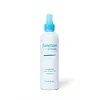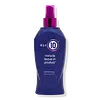What's inside
What's inside
 Key Ingredients
Key Ingredients

 Benefits
Benefits

 Concerns
Concerns

 Ingredients Side-by-side
Ingredients Side-by-side

Water
Skin ConditioningGlyceryl Stearate
EmollientGlycerin
HumectantPolyglyceryl-6 Stearate
EmollientCitrullus Lanatus Seed Oil
EmollientAloe Barbadensis Leaf Juice
Skin ConditioningPersea Gratissima Oil
Skin ConditioningCaprylic/Capric Triglyceride
MaskingPanthenol
Skin ConditioningGuar Hydroxypropyltrimonium Chloride
Skin ConditioningPolyglyceryl-6 Behenate
Emulsion StabilisingIsodecyl Neopentanoate
EmollientPolyquaternium-37
Caprylyl Glycol
EmollientTrideceth-6
EmulsifyingPolyquaternium-113
Hexylene Glycol
EmulsifyingPotassium Sorbate
PreservativeDisodium EDTA
Hydroxyethyl Cetearamidopropyldimonium Chloride
Skin ConditioningC11-15 Pareth-7
EmulsifyingCitric Acid
BufferingStearic Acid
CleansingBenzoic Acid
MaskingPalmitic Acid
EmollientSodium Metabisulfite
AntioxidantTetrasodium EDTA
Stearyl Alcohol
EmollientCetyl Alcohol
EmollientBehenyl Alcohol
EmollientIsopropyl Alcohol
SolventDehydroacetic Acid
PreservativePropoxytetramethyl Piperidinyl Dimethicone
Phenoxyethanol
PreservativeParfum
MaskingCitral
PerfumingCitronellol
PerfumingLinalool
PerfumingLimonene
PerfumingWater, Glyceryl Stearate, Glycerin, Polyglyceryl-6 Stearate, Citrullus Lanatus Seed Oil, Aloe Barbadensis Leaf Juice, Persea Gratissima Oil, Caprylic/Capric Triglyceride, Panthenol, Guar Hydroxypropyltrimonium Chloride, Polyglyceryl-6 Behenate, Isodecyl Neopentanoate, Polyquaternium-37, Caprylyl Glycol, Trideceth-6, Polyquaternium-113, Hexylene Glycol, Potassium Sorbate, Disodium EDTA, Hydroxyethyl Cetearamidopropyldimonium Chloride, C11-15 Pareth-7, Citric Acid, Stearic Acid, Benzoic Acid, Palmitic Acid, Sodium Metabisulfite, Tetrasodium EDTA, Stearyl Alcohol, Cetyl Alcohol, Behenyl Alcohol, Isopropyl Alcohol, Dehydroacetic Acid, Propoxytetramethyl Piperidinyl Dimethicone, Phenoxyethanol, Parfum, Citral, Citronellol, Linalool, Limonene
Water
Skin ConditioningPropylene Glycol
HumectantCetearyl Alcohol
EmollientCyclopentasiloxane
EmollientBehentrimonium Chloride
PreservativePanthenol
Skin ConditioningSilk Amino Acids
HumectantAloe Barbadensis Leaf Juice
Skin ConditioningCamellia Sinensis Leaf Extract
AntimicrobialHelianthus Annuus Seed Extract
Skin ConditioningQuaternium-80
Butylene Glycol
HumectantPhenoxyethanol
PreservativeMethylparaben
PreservativePropylparaben
PreservativeEthylparaben
PreservativeParfum
MaskingCitronellol
PerfumingHexyl Cinnamal
PerfumingLimonene
PerfumingLinalool
PerfumingWater, Propylene Glycol, Cetearyl Alcohol, Cyclopentasiloxane, Behentrimonium Chloride, Panthenol, Silk Amino Acids, Aloe Barbadensis Leaf Juice, Camellia Sinensis Leaf Extract, Helianthus Annuus Seed Extract, Quaternium-80, Butylene Glycol, Phenoxyethanol, Methylparaben, Propylparaben, Ethylparaben, Parfum, Citronellol, Hexyl Cinnamal, Limonene, Linalool
 Reviews
Reviews

Ingredients Explained
These ingredients are found in both products.
Ingredients higher up in an ingredient list are typically present in a larger amount.
Aloe Barbadensis Leaf Juice comes from leaves of the aloe plant. Aloe Barbadensis Leaf Juice is best known for helping to soothe sunburns. It is also anti-inflammatory, moisturizing, antiseptic, and can help heal wounds.
Aloe is packed with good stuff including Vitamins A, C, and E. These vitamins are antioxidants, which help fight free-radicals and the damage they may cause. Free-radicals are molecules that may damage your skin cells, such as pollution.
Aloe Barbadensis Leaf Juice also contains sugars. These sugars come in the form of monosaccharides and polysaccharides, folic acid, and choline. These sugars are able to help bind moisture to skin.
It also contains minerals such as calcium, 12 anthraquinones, fatty acids, amino acids, and Vitamin B12.
Learn more about Aloe Barbadensis Leaf JuiceCitronellol is used to add fragrance/parfum to a product. It is often derived from plants such as roses. In fact, it can be found in many essential oils including geranium, lavender, neroli, and more. The scent of Citronellol is often described as "fresh, grassy, and citrus-like".
Since the Citronellol molecule is already unstable, Citronellol becomes irritating on the skin when exposed to air.
Citronellol is a modified terpene. Terpenes are unsaturated hydrocarbons found in plants. They make up the primary part of essential oils.
Citronellol is not able to be absorbed into deeper layers of the skin. It has low permeability,
Citronellol is also a natural insect repellent.
Learn more about CitronellolLimonene is a fragrance that adds scent and taste to a formulation.
It's found in the peel oil of citrus fruits and other plants such as lavender and eucalyptus. The scent of limonene is generally described as "sweet citrus".
Limonene acts as an antioxidant, meaning it helps neutralize free radicals.
When exposed to air, oxidized limonene may sensitize the skin. Because of this, limonene is often avoided by people with sensitive skin.
The term 'fragrance' is not regulated in many countries. In many cases, it is up to the brand to define this term. For instance, many brands choose to label themselves as "fragrance-free" because they are not using synthetic fragrances. However, their products may still contain ingredients such as essential oils that are considered a fragrance.
Learn more about LimoneneLinalool is a fragrance and helps add scent to products. It's derived from common plants such as cinnamon, mint, citrus, and lavender.
Like Limonene, this ingredient oxidizes when exposed to air. Oxidized linalool can cause allergies and skin sensitivity.
This ingredient has a scent that is floral, spicy tropical, and citrus-like.
Learn more about LinaloolPanthenol is a common ingredient that helps hydrate and soothe the skin. It is found naturally in our skin and hair.
There are two forms of panthenol: D and L.
D-panthenol is also known as dexpanthenol. Most cosmetics use dexpanthenol or a mixture of D and L-panthenol.
Panthenol is famous due to its ability to go deeper into the skin's layers. Using this ingredient has numerous pros (and no cons):
Like hyaluronic acid, panthenol is a humectant. Humectants are able to bind and hold large amounts of water to keep skin hydrated.
This ingredient works well for wound healing. It works by increasing tissue in the wound and helps close open wounds.
Once oxidized, panthenol converts to pantothenic acid. Panthothenic acid is found in all living cells.
This ingredient is also referred to as pro-vitamin B5.
Learn more about PanthenolParfum is a catch-all term for an ingredient or more that is used to give a scent to products.
Also called "fragrance", this ingredient can be a blend of hundreds of chemicals or plant oils. This means every product with "fragrance" or "parfum" in the ingredients list is a different mixture.
For instance, Habanolide is a proprietary trade name for a specific aroma chemical. When used as a fragrance ingredient in cosmetics, most aroma chemicals fall under the broad labeling category of “FRAGRANCE” or “PARFUM” according to EU and US regulations.
The term 'parfum' or 'fragrance' is not regulated in many countries. In many cases, it is up to the brand to define this term.
For instance, many brands choose to label themselves as "fragrance-free" because they are not using synthetic fragrances. However, their products may still contain ingredients such as essential oils that are considered a fragrance by INCI standards.
One example is Calendula flower extract. Calendula is an essential oil that still imparts a scent or 'fragrance'.
Depending on the blend, the ingredients in the mixture can cause allergies and sensitivities on the skin. Some ingredients that are known EU allergens include linalool and citronellol.
Parfum can also be used to mask or cover an unpleasant scent.
The bottom line is: not all fragrances/parfum/ingredients are created equally. If you are worried about fragrances, we recommend taking a closer look at an ingredient. And of course, we always recommend speaking with a professional.
Learn more about ParfumPhenoxyethanol is a preservative that has germicide, antimicrobial, and aromatic properties. Studies show that phenoxyethanol can prevent microbial growth. By itself, it has a scent that is similar to that of a rose.
It's often used in formulations along with Caprylyl Glycol to preserve the shelf life of products.
Water. It's the most common cosmetic ingredient of all. You'll usually see it at the top of ingredient lists, meaning that it makes up the largest part of the product.
So why is it so popular? Water most often acts as a solvent - this means that it helps dissolve other ingredients into the formulation.
You'll also recognize water as that liquid we all need to stay alive. If you see this, drink a glass of water. Stay hydrated!
Learn more about Water